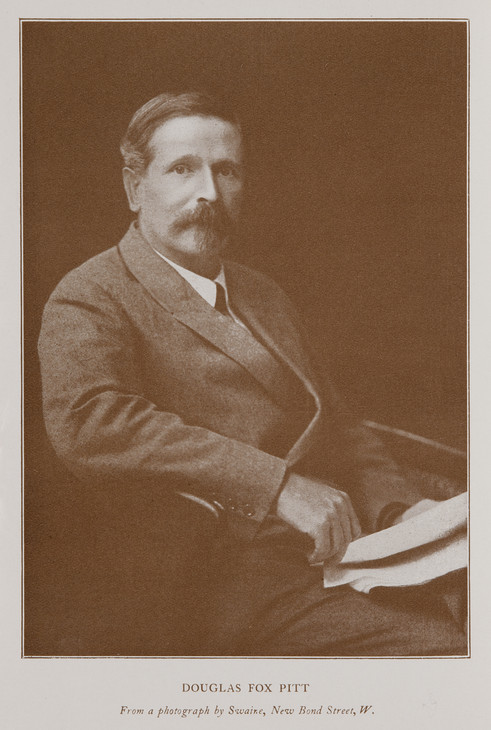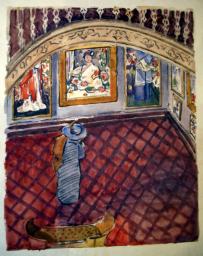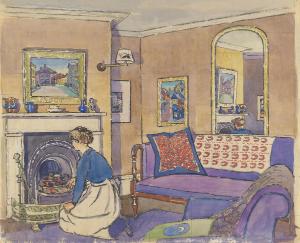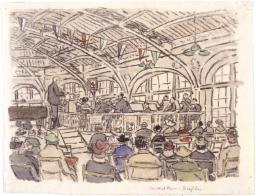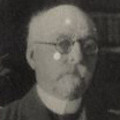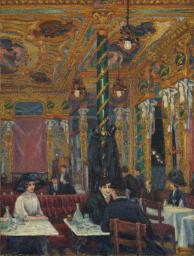Douglas Fox Pitt 1864–1922
Douglas Fox Pitt, born in London on 17 December 1864, came from a large and well-to-do family (fig.1). His father, Augustus Lane Fox, inherited a substantial country estate and changed his name to Fox Pitt Rivers. Now called the ‘father of British archaeology’, Lieutenant-General Fox Pitt Rivers amassed a collection of anthropological and archaeological objects which formed the basis of the Pitt Rivers Museum in the University of Oxford. Douglas, the second youngest of nine children, was freed by his father’s inheritance from the necessity of earning a living but found it hard to settle to a life’s occupation. He first considered becoming an architect and attended the Bartlett School of Architecture in 1881–2 and again in 1889–90. Having also studied at the Royal Agricultural College at Cirencester he tried his hand at farming in Canada and South America but these ventures proved to be failures. He even attempted to join the City Imperial Volunteer unit of the army but was turned down. Around 1890 he began to experiment with painting. He was sufficiently skilled as a draughtsman to be sent to make drawing plans, elevations and sketches of thirteenth-century castles and houses as research for his father’s work as Inspector of Ancient Monuments.1
Despite studying for a short period at the Slade School of Fine Art, during which time he met the painter Harold Gilman, Fox Pitt was largely self-taught. He assiduously studied the work of other artists and began to collect modern paintings himself. Travel was an important feature of his life and he went on a number of painting tours with his close friend and fellow watercolourist, Walter Taylor. During his lifetime he travelled extensively both in Britain and on the continent and went to France, Poland, Corfu, Cyprus and Ceylon. In 1905–6 he visited Morocco in the company of Count Graf Sternberg who later wrote an account of the trip in The Barbarians of Morocco, which was published in1908. Fox Pitt contributed a preface and twelve watercolour illustrations to the publication. The book describes the people and places seen on the journey from Tangier to Fez and makes a plea for ‘Morocco to remain as she is – a land inhabited by naturally peaceful people, unspoilt by modern inventions – an artistic reserve for all those who prefer the beauties of Nature to the throb of an iron piston’.2 The watercolours are executed in loose, wet washes and use pure but subdued colours.
Fox Pitt’s association with the Camden Town Group began through his friendship with Walter Sickert with whom he frequently painted in Dieppe between 1907 and 1921. Although not a member of the Camden Town Group, he frequented the meetings of the Fitzroy Street Group and in October 1911 held a shared exhibition of watercolours with Walter Taylor at the Carfax Gallery. He hugely respected and admired Sickert and his art, writing in the New Age in 1914, ‘People of taste will always be thankful to Mr. Sickert for having founded the Camden Town Group’.3 In turn, Sickert saw merit in Fox Pitt’s paintings, commenting in the Burlington Magazine in 1916 that ‘Mr Fox Pitt’s watercolours seem to me the idea of what a watercolour should be’.4 In 1913 Fox Pitt contributed works to the Brighton exhibition of English Post-Impressionists, Cubists and Others. This show amalgamated the artists of the Fitzroy Street and Camden Town groups and preceded the formation of the London Group, of which Fox Pitt also became a member and regular exhibitor. In 1920–1 he held the position of treasurer for the group, a role he had taken over from Robert Bevan.
From 1911–18, Fox Pitt lived in Brighton. This period was artistically his busiest and most significant. Brighton featured heavily as a subject in his work, and in his landscapes of the piers and beach he developed a characteristic style of flat washes of watercolour over carefully structured linear charcoal underdrawings. While in Brighton he served on the Fine Arts Committee of the art gallery and exhibited at the autumn shows. During the First World War he painted scenes of troops stationed in the town and was also sent to Halifax, Nova Scotia, as part of the creation of artistic records of the conflict for the Department of Information. One of his rarer paintings in oil, The Indian Hospital, the Dome, Brighton, was purchased during his lifetime by the Imperial War Museum.5 After the First World War ended he continued to travel and paint but began to be dogged by ill health. After suffering from cancer he died on 19 September 1922 aged only fifty-seven. Memorial exhibitions were held in 1923 at the Leicester Galleries, London, and the Public Art Galleries, Brighton. James Bolivar Manson wrote that his death ‘ended a devotion to art which was as whole-hearted as it was unobtrusive’.6
Fox Pitt’s importance to the Camden Town Group lies as much in his role as a patron and collector, as in his role as an artist. Although not as wealthy as his friend and fellow collector, Walter Taylor, he bought works by modern French artists such as Henri Matisse and Paul Cézanne. He was also generous in supporting his friends from Fitzroy Street, in particular buying works by Sickert, Gilman and Charles Ginner, including Ginner’s The Café Royal, now in Tate’s collection (N05050). In 1915 he proposed that Gilman paint a portrait of his nephew, then a subaltern in the Welsh Guards.7 Sickert wrote to his friend Nan Hudson, ‘I saw a lovely etching of yours in Fox Pitt’s little house in Brighton. That man is rather touching. He wears old pea jackets of the eighties over his no longer 1880 tum to buy our pictures!’8
Notes
Mark Bowden, Pitt Rivers: The Life and Archaeological Work of Lieutenant-General Augustus Henry Lane Fox Pitt Rivers, DCL, FRS, FSA, Cambridge, New York, Port Chester, Melbourne, Sydney 1991, p.35.
Walter Sickert, ‘A Monthly Chronicle’, Burlington Magazine, January 1916, in Anna Gruetzner Robins (ed.), Walter Sickert: The Complete Writings on Art, Oxford 2000, p.401.
IWM ART 323. Reproduced at Imperial War Museum, http://www.iwmcollections.org.uk/ , accessed 20 January 2011.
Catalogue entries
How to cite
Nicola Moorby, ‘Douglas Fox Pitt 1864–1922’, artist biography, March 2003, in Helena Bonett, Ysanne Holt, Jennifer Mundy (eds.), The Camden Town Group in Context, Tate Research Publication, May 2012, https://www

